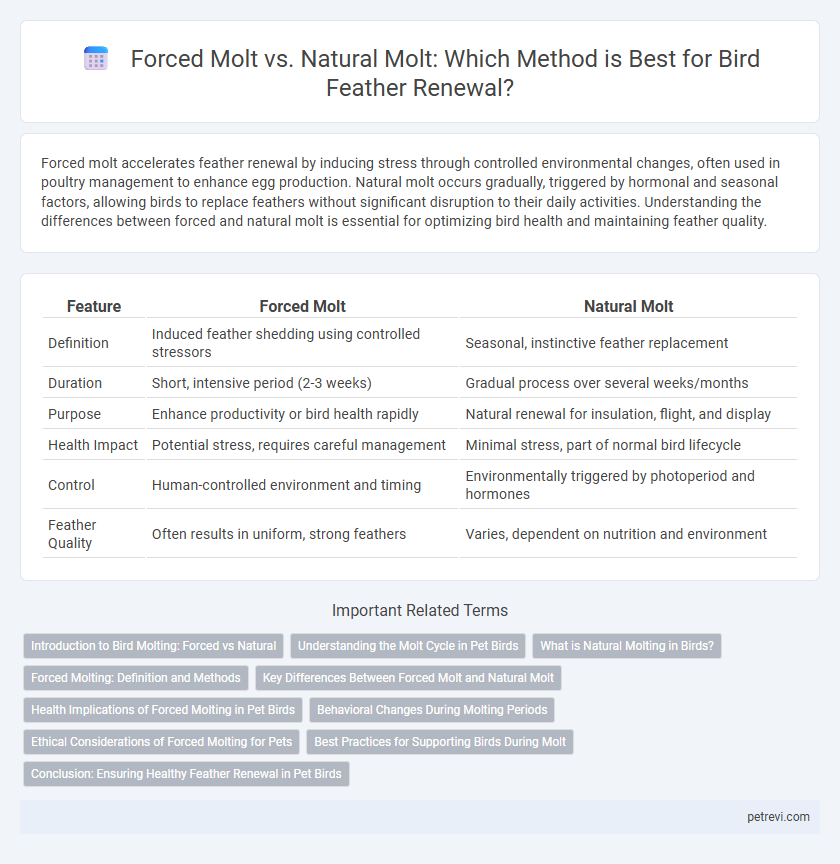Forced molt accelerates feather renewal by inducing stress through controlled environmental changes, often used in poultry management to enhance egg production. Natural molt occurs gradually, triggered by hormonal and seasonal factors, allowing birds to replace feathers without significant disruption to their daily activities. Understanding the differences between forced and natural molt is essential for optimizing bird health and maintaining feather quality.
Table of Comparison
| Feature | Forced Molt | Natural Molt |
|---|---|---|
| Definition | Induced feather shedding using controlled stressors | Seasonal, instinctive feather replacement |
| Duration | Short, intensive period (2-3 weeks) | Gradual process over several weeks/months |
| Purpose | Enhance productivity or bird health rapidly | Natural renewal for insulation, flight, and display |
| Health Impact | Potential stress, requires careful management | Minimal stress, part of normal bird lifecycle |
| Control | Human-controlled environment and timing | Environmentally triggered by photoperiod and hormones |
| Feather Quality | Often results in uniform, strong feathers | Varies, dependent on nutrition and environment |
Introduction to Bird Molting: Forced vs Natural
Bird molting is the process of feather renewal essential for maintaining flight efficiency, insulation, and camouflage. Forced molt, often induced in captive birds through environmental or dietary changes, accelerates feather replacement to optimize health and productivity, especially in poultry industry settings. Natural molt occurs seasonally, driven by hormonal cycles, allowing wild birds to systematically shed old feathers and grow new ones in alignment with environmental conditions.
Understanding the Molt Cycle in Pet Birds
Understanding the molt cycle in pet birds involves recognizing the differences between forced molt and natural molt, both essential for feather renewal. Forced molt, often induced by changing lighting conditions or diet, accelerates feather shedding and regrowth, commonly used in aviculture to improve bird appearance or reproductive performance. Natural molt occurs seasonally, guided by hormonal changes, allowing birds to replace worn feathers gradually without undue stress, supporting overall health and well-being.
What is Natural Molting in Birds?
Natural molting in birds is a biologically programmed process where feathers are gradually shed and replaced to maintain optimal insulation, flight efficiency, and appearance. This cycle typically occurs seasonally and is regulated by hormonal changes triggered by shifts in daylight length and environmental conditions. Unlike forced molt, natural molting allows birds to retain enough feathers to stay protected and mobile throughout the feather renewal period.
Forced Molting: Definition and Methods
Forced molting in birds is a management technique primarily used in poultry to stimulate feather renewal and enhance reproductive performance by inducing a temporary cessation of egg production. This process involves manipulating environmental factors such as feed restriction, reduced lighting, or water withdrawal to trigger a physiological response mimicking natural molting. While effective for revitalizing laying cycles, forced molting requires careful monitoring to mitigate stress and health risks associated with abrupt changes in the bird's condition.
Key Differences Between Forced Molt and Natural Molt
Forced molt in birds is an artificial process induced by manipulating environmental factors like light and diet, leading to rapid feather loss and regrowth, primarily used in poultry production to improve egg-laying performance. Natural molt occurs seasonally, triggered by hormonal changes and photoperiod, allowing gradual feather replacement that supports flight and insulation without significant disruption to normal behavior. Key differences include the speed of feather renewal, physiological stress levels, and the purpose--forced molt is controlled for economic benefits, while natural molt is an inherent biological cycle for maintaining feather condition.
Health Implications of Forced Molting in Pet Birds
Forced molting in pet birds often induces significant stress, leading to weakened immune function and increased susceptibility to infections. Unlike natural molt, forced molting disrupts normal physiological processes by restricting food or altering environmental conditions, which can cause malnutrition and organ damage. Understanding and prioritizing natural molt cycles is crucial for maintaining optimal health and longevity in domesticated bird species.
Behavioral Changes During Molting Periods
Birds undergoing forced molt exhibit more pronounced behavioral changes compared to those in natural molt, including increased rest periods and reduced activity to conserve energy. Natural molting allows gradual feather replacement, enabling birds to maintain regular feeding and social behaviors with minimal disruption. The intensity and duration of molting directly influence birds' foraging, mating displays, and vigilance, crucial for survival and reproductive success.
Ethical Considerations of Forced Molting for Pets
Forced molting in pet birds involves inducing feather loss through stress or dietary restrictions, raising significant ethical concerns due to potential harm and distress caused to the bird. Natural molting is a healthy, instinctive process that allows gradual feather renewal without compromising the bird's well-being or immune system. Prioritizing natural molt supports the animal's health, reduces stress, and aligns with humane pet care practices.
Best Practices for Supporting Birds During Molt
Supporting birds during molt requires providing a nutrient-rich diet high in proteins, vitamins A and E, and omega-3 fatty acids to promote healthy feather regeneration. Ensuring a stress-free environment with minimal handling and adequate hydration helps birds conserve energy and effectively replace their feathers. Offering supplemental lighting that mimics natural daylight cycles can also optimize the molting process by regulating hormone levels crucial for feather growth.
Conclusion: Ensuring Healthy Feather Renewal in Pet Birds
Maintaining a healthy feather renewal process in pet birds requires understanding the differences between forced molt and natural molt. Natural molt allows birds to shed and regrow feathers gradually, supporting optimal feather quality and overall health, while forced molt, often induced by stress or artificial methods, can lead to increased vulnerability and weakened immune response. Prioritizing a natural molt cycle through proper nutrition, environment, and care ensures stronger, vibrant feathers and enhances the bird's well-being.
Forced molt vs Natural molt for Bird feather renewal Infographic

 petrevi.com
petrevi.com